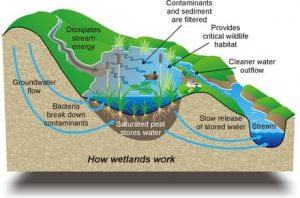‘City in Nature? That’s just rubbish. All our green spaces are fake.‘ These kinds of sentiments are familiar to me, having friends or family bring this up in conversation, critical towards the Singapore government’s new campaign to push for Singapore to be a ‘City in Nature’. Admittedly, I thought like this too – until I experienced Keppel Discovery Wetlands (KDW) at the Singapore Botanic Gardens and saw the amount of effort put into the restoration project. $2.08 million was invested into the restoration of this freshwater wetland ecosystem. The conservation team really stretched their dollars to replicate the ecosystem and provide educational signboards for visitors.
Why dedicate so much money just for a small nature area? Wetlands help many ecosystem services like purifying water, mitigating floods, absorbing carbon from the atmosphere and so much more (Figure 1). These aforementioned functions are just some of many advantages wetlands provide that are relevant to Singapore, which is perpetually threatened by limited water supply, flood risk and excessive carbon emissions that contribute to rising air temperatures. Moreover, in our high-stress urban environment, this nature feature will provide much-needed respite and calm, improving visitors’ well-being.

Figure 1: Graphic representation of how a Wetland Ecosystem functions (Professor Patricia Shapley, University of Illinios, 2009)
However, SBGs maintenance contract ended sometime last year and when we visited it in February 2022, it was saddening to see what happened without maintenance, the freshwater pond has been overtaken by hydrillas (Figure 2). These aquatic, invasive plant species reproduce rapidly and form an impenetrable mat, robbing the fish of oxygen. Invaded areas produce an ugly, foamy ‘scum’ on the water surface (Figure 3). Though it was unclear how hydrilla were introduced into the pond, our professor mentioned that it is likely due to human activity (i.e. unthorough cleaning of the pond, organic matter runoff from external sources) which has unknowingly contaminated the very nature that the SBG restoration team hoped to restore.


Figure 2: Comparison between KDW pond when it first opened in 2017 (Lim Yaohui, The Straits Times, 2017) and the same pond but Hydrilla-infested, in February 2022.

Figure 3: Close up of an area at KDW that was invaded by hydrilla, with a scummy appearance
We need to clean up this mess. The only way to directly remove hydrillas is by scooping up all the fragments. That may be the role of the maintenance people, but it is us – ordinary, everyday people – who fuel the need for maintenance. Without recognition of the importance of these ecosystems, its monetary value is diminished and another precious ‘green’ resource, money, will be channeled away. Even if we are not directly involved in restoration and maintenance work, we too are inevitably integrated into the wetland ecosystem. As each organism has a specific role within the ecosystem, what is ours?
Our role as Singaporeans extends beyond the wetlands itself. For a start, we can support these types of conservation efforts, through donations or advocating for the importance of restoring and maintaining these ecosystems. One ecosystem, when the organisms are functioning harmoniously, is greater than the sum of its parts, and if we wisely integrate well into these ecosystems, I can only imagine how much more vibrant our world will be. We are already a City in Nature, it’s time to live up to that name.
‘Look after the land and it will look after you, destroy the land and it will destroy you’ – Aboriginal Proverb
Written by Elizabeth Chee

Leave a Reply